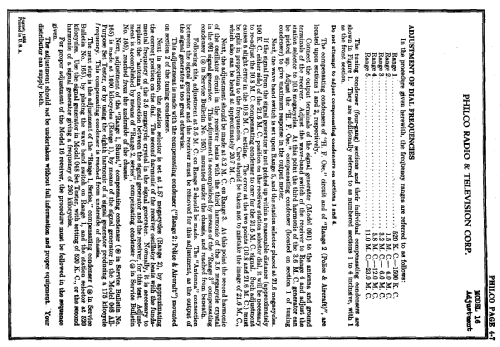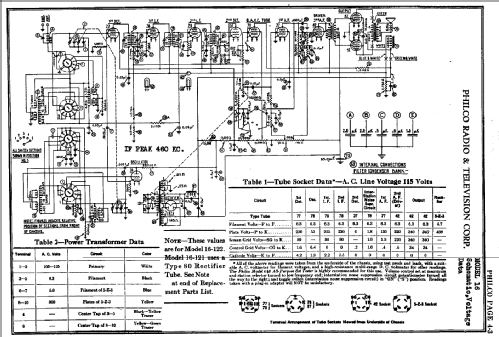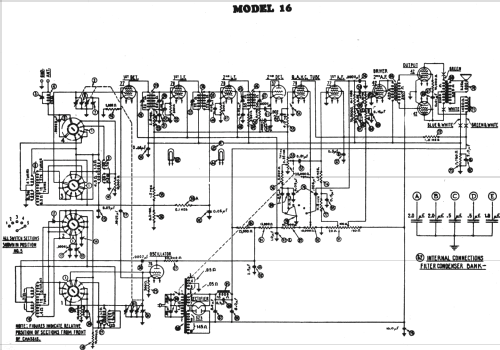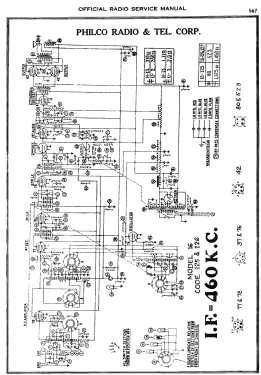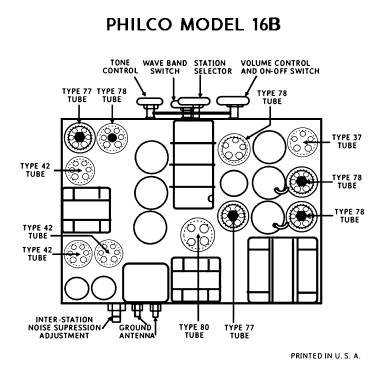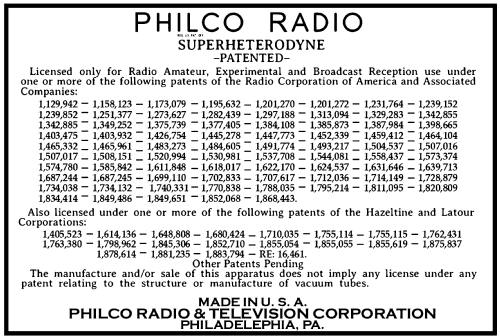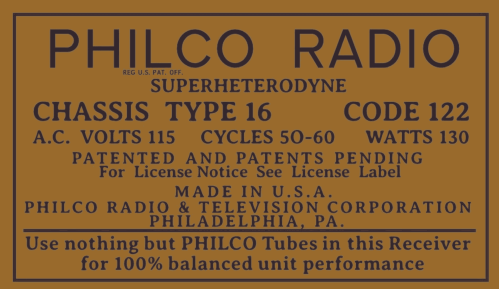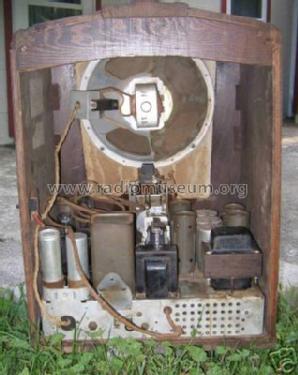16B 16/16A-121 Version 2
Philco, Philadelphia Stg. Batt. Co.; USA
- Produttore / Marca
- Philco, Philadelphia Stg. Batt. Co.; USA
- Anno
- 1934
- Categoria
- Radio (o sintonizzatore del dopoguerra WW2)
- Radiomuseum.org ID
- 118867
Clicca sulla miniatura dello schema per richiederlo come documento gratuito.
- Numero di tubi
- 11
- Principio generale
- Supereterodina (in generale); ZF/IF 460 kHz
- Gamme d'onda
- Onde medie (OM) e più di 2 gamme di onde corte (> 2 x OC).
- Tensioni di funzionamento
- Alimentazione a corrente alternata (CA) / 115 Volt
- Altoparlante
- AP elettrodinamico (bobina mobile e bobina di eccitazione/di campo) / Ø 10 inch = 25.4 cm
- Potenza d'uscita
- 10 W (qualità ignota)
- Materiali
- Mobile in legno
- Radiomuseum.org
- Modello: 16B 16/16A-121 [Version 2] - Philco, Philadelphia Stg. Batt
- Forma
- Soprammobile verticale con decorazioni (Tombstone).
- Dimensioni (LxAxP)
- 16.5 x 21 x 11 inch / 419 x 533 x 279 mm
- Annotazioni
-
The 2nd version of the Philco 16B was introduced in June, 1934. The cabinet has a shallow peaked top with 3 narrow bars running from the front of the cabinet to the back along the peak. It uses the code 121 early chassis.
The model 16 series were high-end multi-band 11-tube radios sold by Philco for about 2 years spanning the 1933, 1934, and 1935 model years. There were two basic versions of the chassis referred to as 'early' and 'late'. Both the early and late chassis used a type 80 rectifier tube for the 16B table models, and a 5Z3 rectifier for the console models. Both chassis included dual IF-amp stages and a shadow meter (tuning aid). Both chassis were available in a version for 25-40 Hz power, and these chassis are marked as "16A" (where the -A suffix is a chassis suffix, not to be confused with the cabinet suffix on the main model number).
The early chassis used in 1933-34 included a QAVC ("quiet automatic volume control") squelch circuit to silence noise between stations. Squelch was implemented with a dedicated type 78 tube, and controlled with an on/off switch on the side and a potentiometer on the back to adjust the squelch level. The early chassis received five bands: 520-1500 kHz, 1.5-4.0 MHz, 3.2-6.0 MHz, 5.8-12.0 MHz and 11.0-23.0 MHz.
The late chassis (1934-35) eliminated the QAVC feature and repurposed its 78 tube to be an RF amplifier stage in the front end, thus maintaining the 11-tube count. The switch on the side of the cabinet was used as a bass-boost control called "Loudness". The late chassis covered a similar tuning range, but with only four bands: 550-1500 KHz, 1.5-4.1 MHz, 4.1-10.0 MHz, and 10.0-22.5 MHz.
The chassis codes are as follows:
Code 121: early chassis with 80
Code 122: early chassis with 5Z3
Code 123: unknown
Code 125: late chassis with 80
Code 126: late chassis with 5Z3
Code 127: unknown
There were fifteen versions of model 16 in different cabinet styles over the three-model-year span:
Four versions of the 16B cathedral/tombstone,
Three versions of the 16L lowboy console,
Four versions of the 16X floor-type console,
Three versions of the 16RX chairside,
A special 16CPX chairside.
- Peso netto
- 19 kg / 41 lb 13.6 oz (41.85 lb)
- Prezzo nel primo anno
- 90.00 $
- Fonte dei dati
- Philco Radio 1928-1942
- Riferimenti schemi
- Rider's Perpetual, Volume 4 = ca. 1934 and before
- Bibliografia
- Collector's Guide to Antique Radios (6th edition)
- Letteratura / Schemi (1)
- Machine Age to Jet Age II (Philco 1928-36 Wiring Diagrams, Parts Lists, and Essential Service Data)
- Autore
- Modello inviato da Konrad Birkner † 12.08.2014. Utilizzare "Proponi modifica" per inviare ulteriori dati.
- Altri modelli
-
In questo link sono elencati 4120 modelli, di cui 2227 con immagini e 3768 con schemi.
Elenco delle radio e altri apparecchi della Philco, Philadelphia Stg. Batt. Co.; USA

